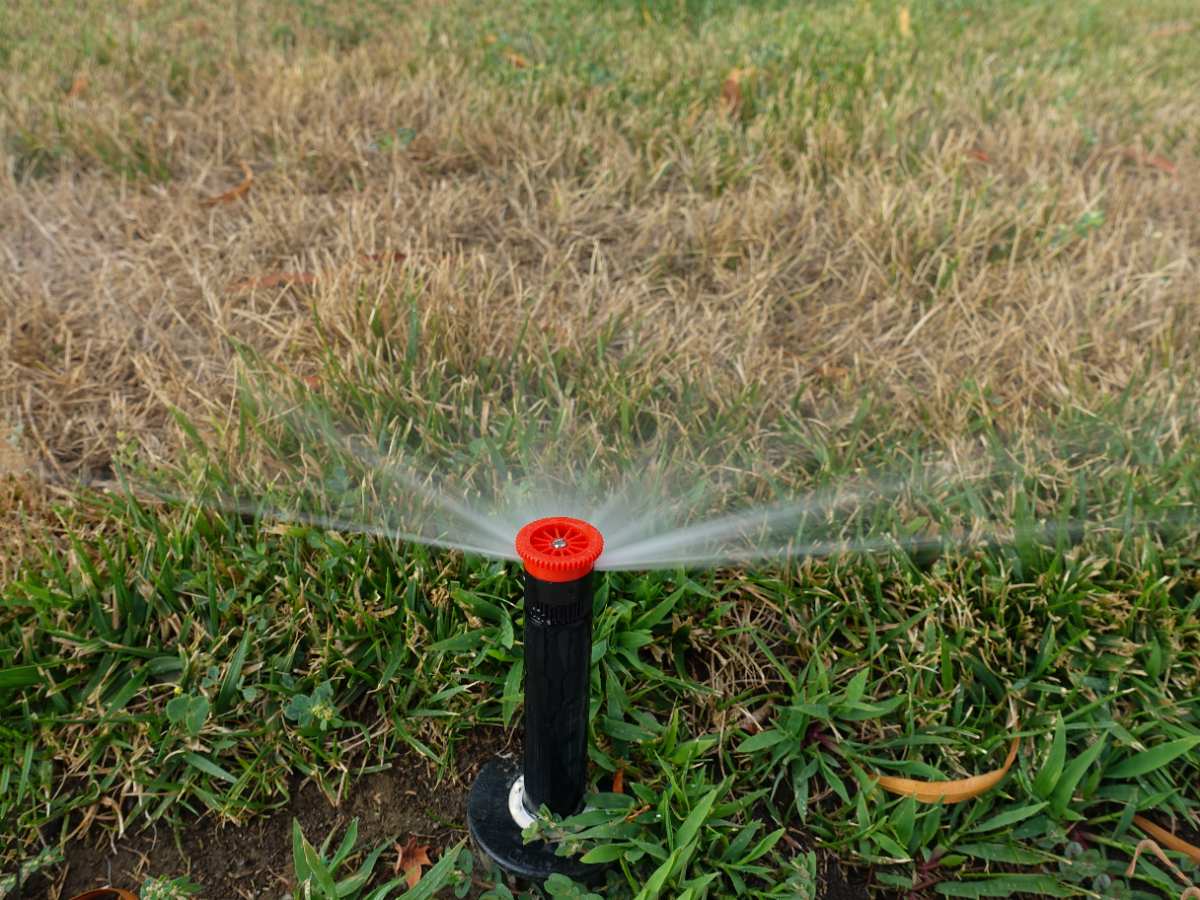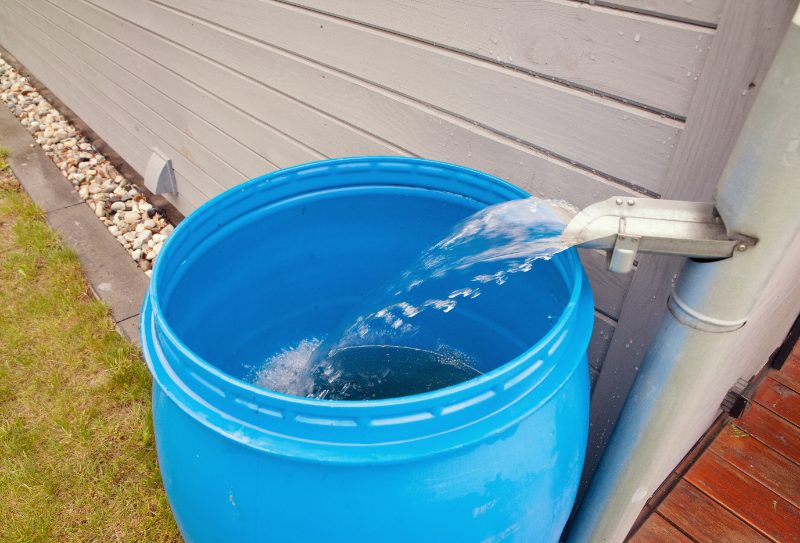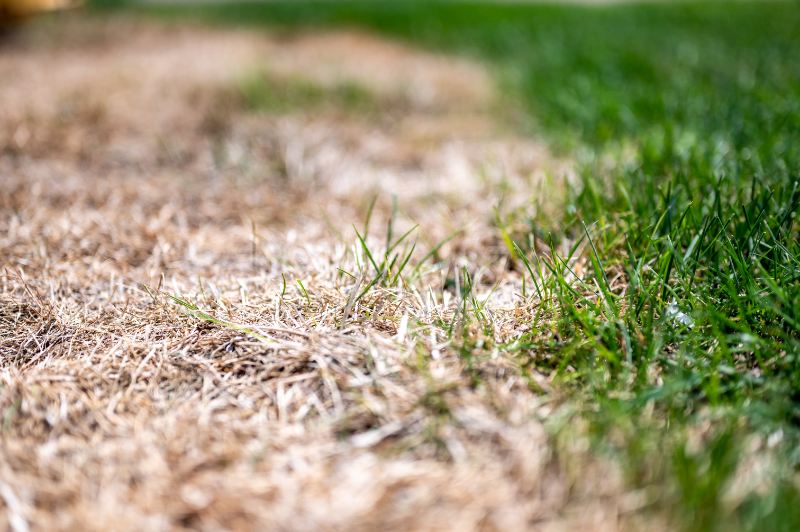
Global warming is causing more dry spells across the country, so you must learn how to take care of your lawn during a drought. Simple adjustments such as smart watering and proper mowing techniques can help.
Additionally, avoiding fertilization and maintaining soil health can help your lawn survive dry spells. We’ve asked an expert for tips on effective lawn care during a drought. Plus, we’ll also share a few recovery techniques you can do to help restore your lawn’s health.
Use Smart Watering Strategies
Simply increasing the amount or frequency of your watering won’t help keep your lawn alive during a drought. Instead, you’ll need smart watering techniques. Here, we’ll discuss the best time to water, how much water to give your grass during a drought, and ways to stretch every drop for maximum benefit.
When to Water
During a drought, the best time to water your grass is early morning (between 4 a.m. and 9 a.m.) when the temperature is at its lowest for the day. This reduces evaporation loss, giving the grass time to absorb moisture before the heat kicks in.
Additional tips:
- Avoid watering in the evening, even during a drought, as it encourages lawn diseases by leaving the grass damp overnight.
- To conserve water, many regions enforce drought watering schedules, limiting lawn watering to specific days and hours. So, check and follow your city’s local watering restrictions.
See Related: How Often to Water Grass in Summer
Note: If you don’t have a drought-tolerant grass lawn that demands less water or can’t tend to your lawn during a drought, you can hire a LawnStarter landscaping pro to install an automatic sprinkler system.
How Much to Water
You’ll want to water your lawn with about 1 to 1.5 inches of water per week to encourage strong root growth.
Watering once or twice a week is better than watering daily. Shallow, frequent watering keeps the grass roots near the surface, making them more vulnerable to drought stress. But watering your lawn deeply but less often can make it more resilient in dry conditions. For sandy soils, though, you’ll need to water more often but less per session.
To avoid overwatering, use the rain gauge or tuna can test. This simple test is cost-effective and surprisingly accurate.
See Related: How Long Should I Water My Lawn?
Water-Saving Techniques

Even if you already have drought-tolerant landscaping, it wouldn’t hurt to use these water-saving methods:
- Install rain barrels under downspouts to collect stormwater for your lawn. Even a quarter inch of rain on a 1,000-square-foot roof can yield over 150 gallons of free water.
- Apply wetting agents or soil surfactants once a month to help water soak evenly into the soil instead of pooling or evaporating.
Note: Sudden heavy rains are not uncommon during a drought. While it can be a relief, it can also cause soil erosion and even flooding.
Similarly, to avoid erosion and runoff (and save water) when you irrigate, use the cycle and soak method, especially on clay soils and sloped landscapes. For each zone, run your sprinklers until water starts to pool. Program that time in your smart controller (“cycle”). Then program a 30 minute to 1 hour rest period (“soak”). Repeat 1-2 more times.
Mow Your Lawn Properly
During a drought, your mowing routine needs a few key adjustments as well.
Jason Lanier, Extension specialist at the University of Massachusetts Amherst, says, “Mowing more frequently than growth demands is unnecessary and can cause undue stress and physical injury to grass plants.”
These simple changes can help your lawn retain soil moisture and reduce lawn stress:
- Raise mowing height to the highest recommended setting for your grass type. Tall grass shades the soil, reducing evaporation and keeping the roots moist.
- Keep blades sharp to create clean cuts that heal faster. Depending on usage, you may have to sharpen your lawn mower blades every 10 hours of mowing.
- Mow less frequently when the grass is growing slowly to reduce lawn stress, advises Lanier. Or, suspend mowing completely if the grass isn’t actively growing.
- Leave grass clippings after mowing your lawn. Using grass clippings as mulch can help return moisture and nutrients to the soil.
| Save time mowing by hiring a LawnStarter mowing pro for around $51 per visit. Our pros completed over 1.8 million mowing jobs last year, and our customers gave them an average rating of 4.5. |
Maintain Soil Health
During a dry spell, you’ll want to:
- Limit foot traffic on your lawn during a drought, even if your grass is resistant to high traffic. Since the grass is already stressed and brittle, keep pets, kids, and lawn equipment off dry areas until the lawn has recovered.
- Eliminate weeds to prevent them from competing with your already-struggling grass for water and nutrients.
If you know a dry summer is coming, there are ways you can prepare in spring. Healthy soil can make a difference during droughts. To make your lawn resilient enough to survive dry conditions, do the following as needed:
- Remove thatch to allow better water absorption. A thick layer of thatch (more than half an inch) blocks water from reaching the soil, acting like a sponge that steals moisture from your grass.
- Core aerate to help water seep down to the grass roots. To aerate your lawn, you’ll remove small plugs of soil, allowing better airflow and water movement.
- Topdress your lawn with compost after aerating it to improve soil structure, boost microbial life, and increase moisture retention.
Note: For your landscaping beds, you’ll want to apply 1 to 3 inches of organic mulch to help cool the soil, conserve moisture, and suppress weeds. Use mulch types like wood chips, bark, or shredded leaves.
See Related: Why Should You Aerate Your Lawn?
| Homeowners who don’t have time to get rid of weeds in flower beds and lawns can hire a LawnStarter lawn care pro for help. Our customers pay an average of $96 for flower bed weeding and give our pros an average rating of 4.5. |
Avoid Fertilization During Drought

During dry spells, fertilizing your lawn can do more harm than good.
“Plants that are not growing because of drought dormancy cannot utilize applied nutrients,” says Lanier. “At a minimum, this is wasteful of resources, including materials, time, and labor, and at worst can result in nutrient loss from the system.”
Do the following to adjust your approach to avoid stressing your lawn further while still giving it what it needs to survive:
- Stop regular fertilization: When water is scarce, fertilizers can’t do the job properly and may even cause fertilizer burn.
- Avoid all nitrogen applications: Nitrogen promotes top growth, which increases your lawn’s water needs. During drought, this added demand can backfire and lead to browning.
- Use only specialized drought-formulated products: If you must fertilize, use products labeled for drought or summer stress.
| LawnStarter pros also do lawn fertilization services, which cost an average of $103 per service. They completed almost 40,000 lawn fertilization jobs last year, and our customers gave them an average rating of 4.4. |
Let Your Lawn Go Dormant
Some homeowners let their lawns go dormant during dry spells (or normal summers for some cool-season grasses) to help them survive drought stress. Note, though, that even dormant lawns need around 1/2 inch of water every 2 to 3 weeks to keep the crowns alive.
Pro Tip: If you choose this option, remember to rehydrate gradually after a drought to avoid drowning weakened roots and inviting disease. Water deeply but infrequently for the first week or two, allowing the soil to dry slightly between sessions.
FAQ About Taking Care of Your Lawn During a Drought
Dormant grass is tan or straw-colored but feels flexible and anchored in the soil. Dead grass is more gray and brittle, and pulls out easily. Read more in our article: Dormant Grass vs. Dead Grass.
After a drought, the following recovery techniques can help your lawn bounce back from drought stress:
✓ Apply a balanced, slow-release fertilizer once moisture returns
✓ Core aerate your lawn to relieve compaction
✓ Overseed damaged areas
✓ Control weeds by hand-pulling or spot-treating with post-emergent herbicides
Wait at least 24 to 48 hours after rain before mowing to let the soil drain and prevent damage to recovering roots. You shouldn’t mow wet grass, as it can cause ruts and stress.
Save Your Lawn From a Drought
Drought doesn’t have to mean the end of your green lawn. With the right care, smart strategies, and a little patience, your grass can bounce back stronger than ever. Need help? Hire a LawnStarter lawn care pro to give your yard expert-level care.
Sources:
- “Compost Can Increase the Water Holding Capacity in Droughty Soils.” By Eliza Hensel, compost systems educator. Michigan State University Extension.
- “Home Lawn Watering Guide.” By Brad Fresenburg, state turfgrass specialist. University of Missouri Extension.
- “How Do I Keep my Lawn Alive in a Drought?” University of New Hampshire Extension.
- Jason Lanier, Extension specialist at the University of Massachusetts Amherst. Personal interview.
- “Lawn Management During Drought.” University of Florida IFAS Extension.
- “Preparing Your Lawn for Drought.” By Mingying Xiang, turf extension specialist. Oklahoma State University.
- “Rainwater Harvesting Systems Guidance for Schoolyard Applications.” By Kimberly Morganello, water resources associate. Clemson University.
- “Soak Up the Rain: Disconnect / Redirect Downspouts.” United States Environmental Protection Agency.
Main Image: Sprinkler waters dying grass during a drought. Photo Credit: Rix Pix / Adobe Stock